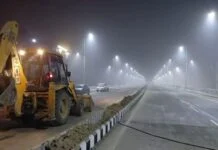Varanasi: India’s railway network, one of the world’s largest, is stepping into the renewable energy era with the recent commissioning of a novel solar panel system between railway tracks at Banaras Locomotive Works (BLW) in Varanasi.
Announced by the Ministry of Railways on August 18, this 70-meter installation—featuring 28 removable panels with a total capacity of 15 kilowatt-peak (kWp)—represents the country’s inaugural effort to harness solar power directly from spaces between railway tracks. Designed to be easily dismantled during train operations, the system ensures minimal disruption while generating clean energy, underscoring India’s innovative approach to blending infrastructure with sustainability.
Also Read: USAID to help Indian Railways achieve net zero goal by 2030
This development comes at a pivotal time as the nation ramps up its green energy initiatives to combat climate change and reduce fossil fuel dependency. It directly supports Prime Minister Narendra Modi’s vision, reiterated at global forums like COP26, where India pledged net-zero emissions by 2070. By tapping into previously overlooked areas like railway corridors, the project could unlock vast potential across the 68,000 km network, contributing to the government’s aggressive solar expansion agenda.
Government Push for Solar: Policies and Incentives Driving Change
The Indian government’s solar strategy is multifaceted, focusing on rooftop and ground-mounted systems to exploit the country’s abundant sunlight. Agencies like the Assam Energy Development Agency (AEDA) promote grid-connected rooftop solar installations, which utilize idle spaces on buildings and offer cost savings of ₹5.0-6.50 per unit over two decades—far cheaper than diesel alternatives. Backed by up to 30% subsidies from the Ministry of New and Renewable Energy (MNRE), these efforts aim to democratize renewable access for households, businesses, and institutions.
Also Read: India a beacon of hope for fight against climate change: IREDA
Nationally, solar energy is projected as a linchpin for energy security. A 2023 report from the Observer Research Foundation (ORF) estimates India’s solar potential at a staggering 7,700 GW by 2070, essential for net-zero ambitions. This aligns with complementary railway advancements, such as the August 12, 2025, commissioning of a 2×25 kV Electric Traction System in Nagda-Khachrod using Scott Transformer technology, which enhances energy efficiency and reduces operational losses.
The BLW initiative builds on this momentum by innovating within existing infrastructure, potentially adding gigawatts if scaled. It reflects a broader shift where railways, traditionally energy-intensive, are evolving into net energy producers through renewables.
Also Read: A leap towards green: Bihar unveils new renewable energy policy
Analyzing the Net-Zero Roadmap: Ambitions, Progress, and Hurdles
India’s net-zero commitment requires transformative growth in renewables. From a 2023 base of around 110 GW in solar and wind capacity, installations must surge 70 times to hit 7,700 GW by 2070—an annual pace of 150-200 GW. As of mid-2025, solar capacity has climbed to approximately 150 GW, including projects in pipeline, according to Ministry of Power data. This puts the country on track for its interim 500 GW renewable target by 2030, with about 40% already achieved.
However, the path is fraught with challenges. Financing the $10-15 trillion needed demands a clear green taxonomy and incentives to attract investors. Land acquisition remains contentious, as seen in recent Assam disputes over 3,000 bighas for renewable projects, highlighting the need for transparent processes to avoid community backlash. Technological barriers, including grid integration and storage solutions, must also be addressed to handle intermittent solar output.
Also Read: Jharkhand to get new Solar Policy, aims 4000MW green energy in 5yrs
Realistically, the 2070 goal is attainable with disciplined execution. The BLW project’s 15 kWp may seem nominal, but nationwide replication could contribute 1-2% to the total target, while slashing railways’ 2% share of national emissions (per 2023 NITI Aayog estimates). Success hinges on holistic decarbonization—beyond solar, incorporating hydrogen fuels, carbon capture, and electrification in transport and industry sectors.
Broader Implications: Sustainability Meets Economic Efficiency
The removable solar system’s design preserves track usability, allowing seamless integration into daily operations—a feature lauded by the Ministry of Railways on social platforms. It complements other eco-friendly rail achievements, like the Ahmedabad Division’s August 2025 freight haul of 3,851.2 tonnes of industrial salt, generating Rs. 31.69 lakh in revenue while promoting low-emission logistics.
Also Read: IRCTC account holders can book tickets for others: Indian Railways
Analytically, this innovation could lower operational costs for Indian Railways, which consumes vast electricity volumes. By generating on-site power, it reduces grid dependency and emissions, fostering a model for other infrastructure-heavy sectors. Yet, scalability depends on pilot outcomes: If proven effective, it could inspire global adaptations, positioning India as a leader in hybrid renewable-transport solutions.
Balancing Growth and Green Imperatives
The BLW solar installation encapsulates India’s renewable ethos—innovative, incremental, and aligned with long-term vision. As the nation navigates economic expansion amid climate imperatives, such projects offer tangible progress. With policy continuity, private partnerships, and community engagement, the daunting 7,700 GW milestone could evolve from ambition to reality. Ultimately, initiatives like this not only advance net-zero but also ensure sustainable development, where environmental stewardship fuels prosperity rather than constraining it.




